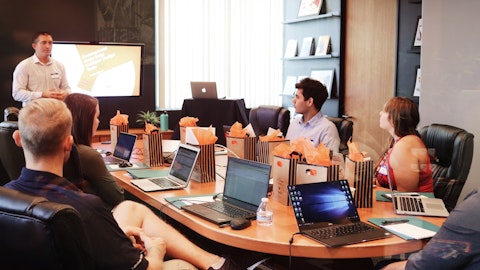BlackRock Capital Investment Corporation (NASDAQ:BKCC) Q1 2023 Earnings Call Transcript May 2, 2023
BlackRock Capital Investment Corporation beats earnings expectations. Reported EPS is $0.12, expectations were $0.11.
Operator: Good morning. My name is Karen, and I will be your conference facilitator today for the BlackRock Capital Investment Corporation First Quarter 2023 Earnings Conference Call. Hosting the call will be James Keenan, Chairman and Interim Chief Executive Officer; Nik Singhal, President; Chip Holladay, Interim Chief Financial Officer and Treasurer; Laurence D. Paredes, General Counsel and Corporate Secretary; Jason Mehring, Managing Director and member of the company’s Investment Committee. Lines have been placed on mute. After the speakers’ complete their update they will open the line for a question-and-answer session. Thank you. Mr. Paredes, you may begin the conference.
Laurence Paredes: Good morning and welcome to the first quarter 2023 earnings conference call of BlackRock Capital Investment Corporation or BCIC. Before we begin our remarks today, I would like to point out that certain comments made during this conference call and within corresponding documents contain forward-looking statements subject to risks and uncertainties. Many of these forward-looking statements can be identified by the use of words such as anticipates, believes, expects, intends, will, should, may, and similar expressions. We call your attention to the fact that BCIC’s actual results may differ from these statements. As you know, BCIC has filed with the SEC reports, which lists some of the factors which may cause BCIC’s results to differ materially from these statements.
BCIC assumes no duty to and does not undertake to update any forward-looking statements. Additionally, certain information discussed and presented may have been derived from third-party sources and has not been independently verified. Accordingly, BCIC makes no representation or warranty with respect to such information. Please note, we have posted to our website an investor presentation that complements this call. Shortly, our management team will highlight some of the information contained in the presentation. The presentation can be accessed by going to our website at www.blackrockbkcc.com and clicking the May 2023 Investor Presentation link in the Presentations section of the Investors page. I would now like to turn the call over to Jim.
James Keenan: Thank you, Larry. Good morning and thank you for joining our first quarter earnings call. After I prove an overview of our performance and highlights for the quarter, Nik will give an update on our portfolio activity and Chip will discuss our financial results in more detail and then we’ll open the call to your questions. Building on the momentum we generated over the past couple of years, we produced another strong quarter by further diversifying our portfolio and increasing net investment income. We selectively identified several compelling investments during the quarter, while benefiting from higher LIBOR and so SOFR rates in an improved pricing environment for new originations to drive a 9.5% sequential increase in NII as compared to the prior quarter.
Our NII covered our $0.10 dividend by 122% this quarter, up from 112% in the fourth quarter of 2022, marking our third consecutive quarter of full dividend coverage. This is a reflection of our deliberate strategy to grow our loan portfolio with high quality investments. As is evident from the results over the last several quarters, we have made significant progress with this strategy. We had no new non-accrual investments in the first quarter. The vast majority of our investments are in first lien positions where we have extensive downside protection. In the current market environment, we have been able to structure new loans with improved pricing, lower leverage, and a more favourable documentation. Our first quarter weighted average portfolio yield increased by 50 basis points from the fourth quarter to 12.4% based on total portfolio fair value.
We have a solid foundation to continue our pursuit of prudent growth, adding to our portfolio’s earning power and delivering consistent and favourable risk adjusted returns to our shareholders. Our net leverage for the first quarter increased to 0.81 times from 0.77 times from the prior quarter, driven by $37.6 million of new deployments, nearly all and first lean loans. We added eight new portfolio companies, boosting our total to 121 as compared to 116 at the close of 2020 86 times at the end of 2021 and 55 times at the end of 2020. Notably, our current leverage leaves us ample runway to further diversify the portfolio, as we draw upon our team’s deep expertise across multiple cycles and the power of BlackRock platform to identify compelling income producing investment opportunities.
First, lean investments now make up 82% of our portfolio, another record for BCIC. This marked a dramatic improvement from 50% at the end of 2020. Junior capital investments now comprise only 5% of our portfolio, down from 23% at the end of 2020; an another indicator of our substantial and ongoing improvement in the credit quality and positioning of our portfolio. While the US job market remains resilient, amidst higher inflation and interest rates, we are mindful that such conditions have historically resulted in slower economic growth or contraction, creating tiny financial conditions for borrowers. We believe that the diversified nature of our portfolio with the prevalence of first lien loans as well as high quality of ownership support in our portfolio companies, help us to be defensively positioned in an economic downturn.
We communicate regularly with our portfolio companies to assess their financial health and outlook, and we are well equipped with the experience and resources to proactively engage with the management teams in the event of emerging challenges. For now, our investments continue to perform well and our credit quality remains strong. We are confident in our ability to succeed across economic cycles, while generating improved profitability on behalf of our shareholders. I’ll now turn the call over to Nik to discuss our portfolio activity in further detail.
Nik Singhal: Thanks, Jim. We again made steady progress this quarter, towards increasing our core earnings power. We provided capital to eight new and several existing portfolio companies, with a weighted average interest rate of 11.9% up from 11.5% on our new deployments from the prior quarter. Approximately, 26% of investment dollars went into existing relationships. First quarter investments in new portfolio companies were nearly all in first lean loans, consistent with a strategy of maintaining a lower risk profile, especially as the risk of a recession remains ahead of us. Exits and repayments during the quarter were $21 million. This included the full exits of our investments in Zest Acquisition. Corp and Kemmerer and Advanced Lighting.
Kemmerer and Advanced Lighting were both legacy non-core positions and we realized approximately $3 million of proceeds from the exit of those investments. Advanced Lighting was also a prior non-accrual investment. So far in the second quarter, we’re seeing a steady flow of opportunities across both new and existing names; although we continue to be very selective about what we invest in. Since the end of the first quarter, our investment committee has approved transactions of $12 million that have either closed subsequent to the first quarter or our pending close, although there can be no assurances that all such transactions will close. Our three largest new portfolio company investments in the first quarter include, a $6.1 million, so far plus 7.5% first lean term loan and $0.7 million unfunded commitments to Showtime Acquisition, L.L.C., a live dinner attraction and family entertainment operator, a $5.9 million, so far plus 7.25% first lean term loan and $0.5 million unfunded revolver to Bynder in digital asset management provider and a $5.1 million, S plus 7.5% first lean term loan and $0.5 million unfunded revolver to Duck Creek, a property and casualty software provider.
Our NAV per share increased by 0.5% in the first quarter, largely driven by net investment income exceeding our dividend. Portfolio marks were approximately flat from the fourth quarter. As previously mentioned, we had no new non-accruals during the first quarter. We feel confident about our overall credit quality and believe that we are well-positioned to withstand the impact of a potentially deteriorating economic environment. We’re pleased to once again achieve more than full coverage of our dividend, even if we excluded the benefit of one-time fee income. We remain conservative in underwriting new investments and vigilant in monitoring our existing portfolio. We still have room to grow our portfolio towards our target leverage range. As we continue to evaluate the pipeline of attractive opportunities in this market, we will remain disciplined in our approach.
I’ll now turn the call over to Chip to further discuss our financial results for the quarter.
Chip Holladay: Thank you, Nik. I will now take a few minutes to review some additional BCIC financial results for the first quarter. GAAP net investment income for the first quarter was $8.9 million or approximately $0.12 per share, an increase of over 9% from the fourth quarter and up 36% from the first quarter of 2022. NII provided first quarter dividend coverage of 122% as compared to 112% in the fourth quarter and up substantially from 88% coverage in the first quarter of 2022. Our gross investment income was $18.8 million for the first quarter, an increase of 7% from the prior quarter and up 54% from the first quarter of 2022. The increase was driven primarily by the impact of a higher interest rate environment, net deployments of approximately $25 million over the past two quarters, and a performing portfolio with no new non-accrual assets.
Company’s weighted average portfolio yield based on fair value increased to 12.4% at quarter end, up from 11.9% at December 31. Total net expenses for the first quarter increased by approximately $0.5 million from the fourth quarter, primarily driven by an increase in interest in other borrowing costs. New to an uptick in our average outstanding debt balance quarter-over-quarter and an increase in LIBOR rates. Portfolio valuations remains relatively flat quarter-over-quarter due to stabilizing credit spreads and a slight increase in the unrealized value of our interest rate swap. We recorded total net unrealized gains of $0.3 million in the first quarter. We also recorded realized losses of $0.6 million in the quarter, upon exiting two non-core positions in Kemmerer and Advanced Lighting.
At quarter end, the portfolio had two non-accrual investments representing 2.7% of our portfolio’s total fair value, down from 4.4% as of March 31, 2022. Our weighted average internal portfolio rating at fair value remained fairly consistent at 1.35 as compared to 1.33 at year end. At quarter end, total available liquidity for deployment and general operating use was approximately $98 million, including cash on hand and subject to leverage and borrowing base restrictions. Our net leverage ratio was 0.81 times up from 0.77 times at the end of the fourth quarter, due to approximately $10 million in net borrowings during the quarter to fund new deployment. As announced yesterday, we declared a quarterly dividend of $0.10 per share, payable on July 06, 2023 shareholders of record at the close of business on June 15, 2023.
With that, I would like to turn the call back to Jim.
James Keenan: Thank you, Chip. In closing, our strategy of portfolio diversity, senior positioning and discipline growth, puts BCIC in great shape for the year ahead and we are confident in our ability to drive strong profitability and strong returns for our shareholders. With that, we would now like to open the call for your questions.
Q&A Session
Follow Blackrock Capital Investment Corp (NASDAQ:BKCC)
Follow Blackrock Capital Investment Corp (NASDAQ:BKCC)
Receive real-time insider trading and news alerts
Operator: We’ll take our first question from Finian O’Shea with Wells Fargo Securities. Please go ahead.
Finian O’Shea: Hi everyone. Good morning. On the portfolio overall, we saw a couple of borrowers migrate to partial pick this quarter. Can you give us a sense of your discussions with borrowers if we should see more of this in the coming quarters or if you have any outlook on what peak might reach as a percent of revenue this year?
Nik Singhal: Hi, good morning, Finian. This is Nik. Let me let me first just give some overarching commentary on the portfolio. Then I can address your specific question about the peak. So overall, I would say that the portfolio we feel has held up very well. There were no new non accruals in the first quarter. In certain sectors we are seeing a slowdown in revenue growth and needless to say, persistent inflation is impacting margins at some companies. What we’re seeing are many of these borrowers or their private equity sponsors adjusting to this reality by rightsizing their cost structure in-or passing the increased cost to their customers and much of this happened in the second half last year. Those — the impact of those initiatives is starting to show up in their financials a bit with a lag, and we see more and more of that activity on an ongoing basis.
We take comfort in the fact that we are first lean heavy with a substantial capital behind us in the borrows capital structure. We structure and underwrite our loans to be resilient in down cycles like this one and importantly, most of our loans are financial covenants, which facilitate a seat at the table in the event of adverse performance. Specifically, I would note there was one name where the conversion to peak was via an amendment. That’s our investment in Razor and the other name where part of the interest converter peck was actually contractual. We have that feature in some of our more tech-oriented names and we actually anticipate that that sort of conversion will be used from time to time. So, that’s the sort of overall commentary I would give.
Our peak income was approximately 6% of total income in the first quarter. We engage with our portfolio companies almost on a continuous basis throughout the quarter. Again, could over time as things progress, could the peak income increase over time, that’s a possibility. But we’re also seeing on the other hand, a number of the companies taking all the actions that they need to take to preserve margins in this market.
Finian O’Shea: That’s a very helpful color. Thank you. And just as a follow up sort of related question, on if you have these numbers for the, for the overall portfolio, what’s the current or forward-looking fixed charge coverage and then what percent of the portfolio is underwater or under one?
Nik Singhal: Yeah, so, and I don’t have the exact numbers in front of me right now, but what I can say is that, when we underwrite new loans at inception, generally we require the interest coverage ratios to be strong call it two and a half to three times, in many cases, even more than three times. And largely because of LIBOR and SOFR having gone up, we’ve seen contraction in those ratios and I would say in an aggregate basis, they maybe come down by a turn. So, the look at the median and discover ratio there might be in the high ones or low twos at this point in time compared to two and a half to three times at origination and the one thing I would say is that when we speak to our borrowers, we’re very, very focused on their liquidity situation and we were starting to see liquidity getting tighter for some of the names in Q3 and Q4.
Surprisingly in many of those names we’re actually seeing the liquidity situation get better as the owners continue to take the right actions to manage their cash flow.
Finian O’Shea: Okay. And that’s helpful. And just one more for me, can you talk about the remaining securities related to Gordon Brothers, how that portfolio is performing in any outlook for that eventual off ramp? And that’s all for me. Thank you.
Nik Singhal: Yeah, so, if you will recall, we monetized most of our GBFC possession back in November, 2020, and GBFC itself was left with certain additional assets that one have continued to provide a source for additional pay-downs since that time. And we expect will continue to provide additional recoveries over time. The exact timing is just by its nature uncertain. I would say it’s not — it’s not a few quarters. I think it’s going to be over the next several quarters. And while we can talk about the underlying portfolio at Teledyne, specifically, what we can tell you is that the reference portfolio of loans to which the first loss not related continues to shrink in size as Teledyne realizes exits and recoveries on those lines.
Operator: We’ll take our next question from Melissa Wedel with JPMorgan.
Melissa Wedel: Thanks very much. Appreciate you taking my questions today. I think you covered a lot of it, but I was hoping to follow on in a couple of areas. First, Nik, I believe you gave an update on activity quarter-to-date of roughly $12 million of originations. Just wanted to make sure I heard that right. And then I don’t think I caught anything that you mentioned perhaps on exit for the quarter to date? Or did I miss it?
Nik Singhal: Yes. No. So that is correct, Melissa. $12 million is the expected number. But again, keep in mind that that’s only first four weeks of the quarter. And so things can change, right, in the remaining two months. Again, I think the point I would enforce is that we’re seeing opportunities. Even though overall M&A activity is very slow in the market. It’s not zero. We’re still seeing dealmaking activity. The one thing we can assure you is that we will continue to remain selective in the opportunities we invest in and also every quarter, our existing portfolio companies continue to be an important source of deployment opportunities. And these are not defensive deployments. These are good deployments that we want to make to help our companies grow.
And again, I think what we feel good about is we have enough dry powder to take advantage of the market conditions we are in right now. Obviously, rates are up, spreads are attractive and we’re also saying it’s not sort of the borrowers market that used to be. We can get favorable documentation. We can get tight cushion on covenants. So it’s really a good period of time to be deploying capital in. And on the repayments, correct that we did not have any repayments or at least any material repayments in the quarter so far.
Melissa Wedel: Okay. Got it. And I appreciate that context. It did jump out to us that you guys are finding opportunities in a lot of new portfolio companies, which is consistent with what your stated goal has been, of diversifying the portfolio. Just conceptually, is that intention — or is that diversification of the portfolio somehow intention with the idea of keeping your lending standards incredibly tight. And arguably, we see a lot of managers deploying primarily to existing borrowers because they know them. There’s that sense of we know the business better. How do you guys approach that? And is there a point at which you might feel like the diversification piece should take a back seat to sort of deploying to companies that you know better. Hopefully, that makes sense.
Nik Singhal: Yes. So — yes. No, it does. I’m going to answer to is, right? First, the strategy to diversify is 100% intentional, right? We are focused on creating NAV stability, predictable net investment income. And we feel that achieving portfolio diversification is a key tool in delivering that to our shareholders, okay? Secondly, the way our platform, the BlackRock direct lending platform has evolved and grown over time. It actually tremendously helps BCIC in achieving diversification. And what I mean by that is that the team that supports BCIC also supports a much larger direct lending platform, which enables us to be a player in scale and size. So as an example, we might be participating in an investment that, call it, $100 million, $200 million, even more in size.
And then we allocate it across multiple different funds, including BCIC, right? So we’re getting the benefit of being a scaled lender. And at the same point of time, BCIC is getting the benefit of diversification, right? So that’s my response from an overall strategy perspective. And then I think the second part of your question was new investments versus existing portfolio companies. I think we have both tools opened, right? And you’ll see that percentage vary from quarter-to-quarter. I think in the past, it has ranged from 20% to 50%. We don’t necessarily have any preconceived notions there. It’s all about putting our capital in the best available opportunities. But if you look at the number of portfolio companies, it’s 121 portfolio companies.
That’s a massive, massive improvement from the 27-or-so portfolio companies BCIC had a few years ago, right? So it’s truly a diversified portfolio at this point in time.
Melissa Wedel: Certainly. Point taken. If I could follow on with sort of my persistent question quarter-over-quarter, we did notice on repurchase activity that there wasn’t any in this quarter. Following a decent track record, I think it was seven-ish quarters prior to that of some share repurchase. Can you — given that you do have plenty of room to increase leverage and that share repurchases are inherently levering activity. Can you update us on just how you’re thinking about that now and what has changed, if anything?
Nik Singhal: Yes, Melissa. So in terms of the share repurchases being one of our tools to deliver shareholder value, nothing has changed with respect to that. We and the Board assess the plan every quarter. And any repurchases that we make are conducted pursuant to the provisions of rules, 10b5-1 and 10b-18. And once that program is in place, repurchases are out of control. So you’ll — it’s possible to see variability quarter-over-quarter and I’m just going to — unfortunately, I can’t comment anymore. So I’ll leave it there.
Melissa Wedel: Okay. Thank you, Nik.
Operator: That concludes today’s question-and-answer session, and this concludes today’s call. We thank you for your participation. You may now disconnect, and have a great day.
Follow Blackrock Capital Investment Corp (NASDAQ:BKCC)
Follow Blackrock Capital Investment Corp (NASDAQ:BKCC)
Receive real-time insider trading and news alerts





